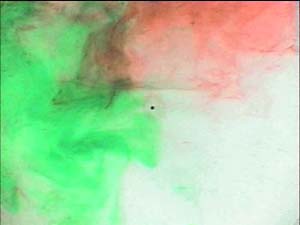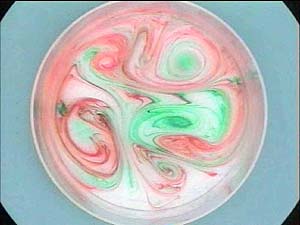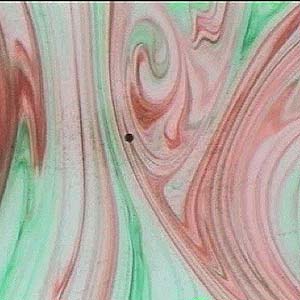Non-rotating
In the non-rotating tank, the dye disperses much as we might intuitively expect – have a look at the pictures below and the movie. Note that the side view on the left-hand side of the images below are obtained using a mirror sloped at 45 degrees and viewed through the camera from above.
In the non-rotating tank, the dye disperses much as we might intuitively expect – have a look at the pictures below and the movie. Note that the side view on the left-hand side of the images below are obtained using a mirror sloped at 45 degrees and viewed through the camera from above.
Rotating
Dye stirred in to the rotating body of water behaves in a very different manner from that in the non-rotating case – have a look at the images below and the movie. Note that the movie is recorded in the frame of reference of the tank, i.e. by a camera mounted above the rotating table, rotating at exactly the same speed. We see beautiful vertical streaks of dye falling vertically; the vertical streaks become drawn out by horizontal fluid motion into vertical ‘curtains’ which wrap around one another.The vertical columns, called ‘Taylor columns’ after G.I. Taylor who discovered them (see Section 7.2 here for more background) – are a result of the rigidity imparted to the fluid by the rotation of the tank. The water moves around in columns which are aligned parallel to the rotation vector. Since the rotation vector is directed upward, the columns are vertical. Thus, we see that rotating fluids are not really like fluids at all!
Dye stirred in to the rotating body of water behaves in a very different manner from that in the non-rotating case – have a look at the images below and the movie. Note that the movie is recorded in the frame of reference of the tank, i.e. by a camera mounted above the rotating table, rotating at exactly the same speed. We see beautiful vertical streaks of dye falling vertically; the vertical streaks become drawn out by horizontal fluid motion into vertical ‘curtains’ which wrap around one another.The vertical columns, called ‘Taylor columns’ after G.I. Taylor who discovered them (see Section 7.2 here for more background) – are a result of the rigidity imparted to the fluid by the rotation of the tank. The water moves around in columns which are aligned parallel to the rotation vector. Since the rotation vector is directed upward, the columns are vertical. Thus, we see that rotating fluids are not really like fluids at all!
From the movie loop of the dye in the rotating frame, estimate the Rossby Number – see Section 7.1 here. Is the Rossby number large or small? See the table on measures of rotation rate for help on converting rotation rates.



